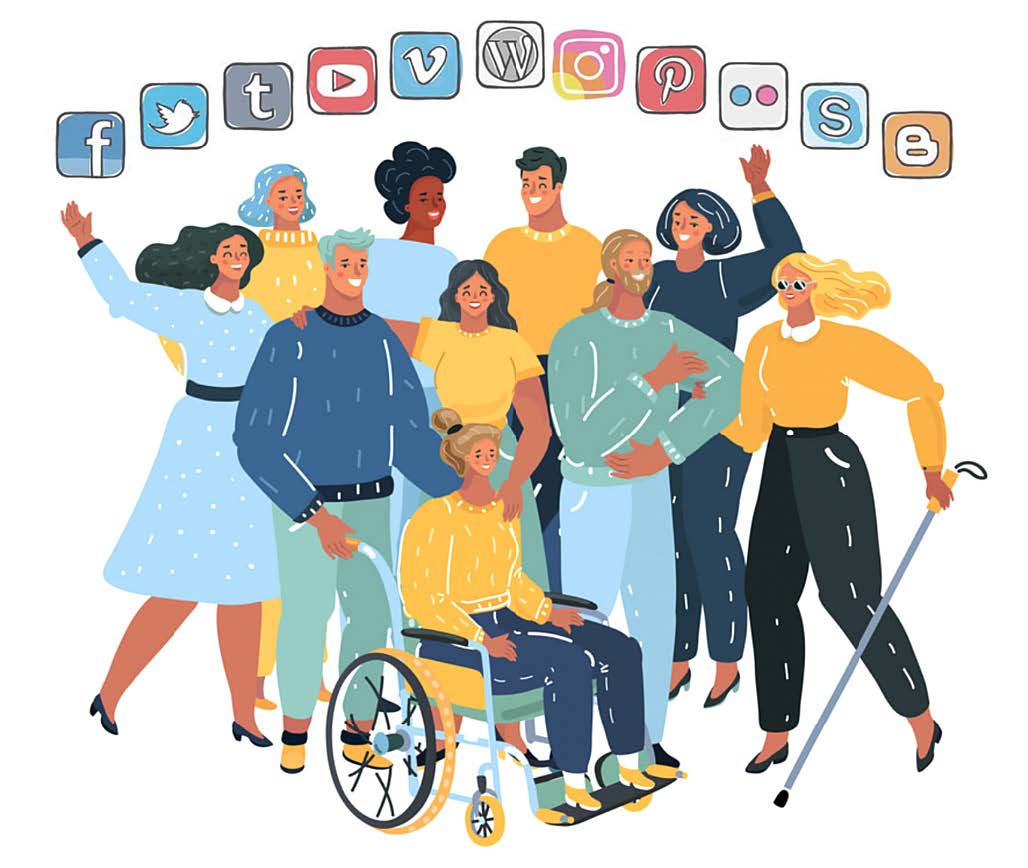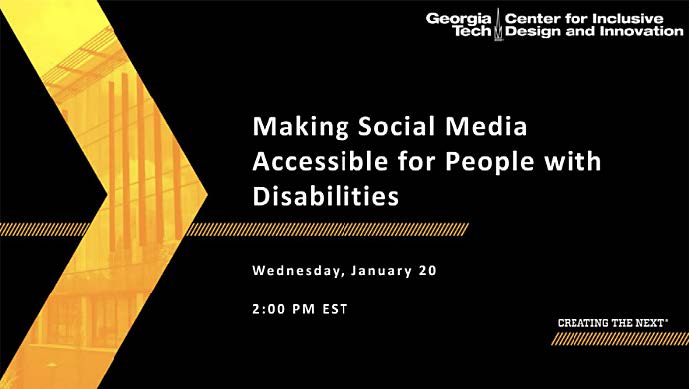HOW ACCESSIBLE IS YOUR SOCIAL MEDIA?

REMOVING BARRIERS: Tools for Life's Best Practices recommendations include appropriate color contrast of all posts, alt text for all images, short and concise text for posts and captions for all videos.
SUBMITTED BY THE CENTER FOR INCLUSIVE DESIGN & INNOVATION, GEORGIA INSTITUTE OF TECHNOLOGY
Social media has always been a resource for sharing information, connecting communities, and enhancing the learning experience. Having a disability during a pandemic has made social media a vital tool for avoiding isolation, having fun, and staying informed. The Center for Inclusive Design and Innovation (CIDI) at Georgia Institute of Technology has been committed to serving the disability community for more than 20 years.
CIDI ( cidi.gatech.edu) has partnered with the CDC Foundation ( cdcfoundation.org) to ensure information related to COVID-19 is available to all people by developing and circulating accessible CDC guidance. The Centers for Disease Control and Prevention ( cdc.gov) has provided technical assistance to this project.
"Research has found there is a significantly higher death rate from COVID-19 for people with certain disabilities, often because they also have underlying conditions that put them at higher risk for severe illness," says Carolyn Phillips, Co-Director of CIDI. "As a parent of a child with disabilities, I witness first-hand the critical need to make social media accessible so everyone can access the same information in a way that makes the most sense to them." As social media is a main source for delivering information, it is increasingly important to make sure it is accessible to the people who are in need of it the most.
The CIDI/CDC Foundation partnership has overseen the development and production of braille documents, mailed free of charge to consumers, downloadable and accessible Word and PDF documents, documents with easy-to-read language, and related resources to offer to various communities. There are ongoing efforts to produce more accessible documents, community partnerships, and resources such as American Sign Language videos and webinars to assist in spreading awareness and safety for everyone.
"When creating public health messages, it's imperative that all individuals are able to easily access and understand these communications," said Lauren Smith, MD, MPH, chief health equity and strategy officer, CDC Foundation. "Our work with CIDI and CDC allows people with disabilities to receive and understand these important health messages especially during the challenging times we are facing now with COVID-19."
With social media being a major outlet for news and entertain ment, being accessible is not always an included feature of its design. Utilizing social media as a means to reach various disability communities has been particularly important in community-building online, but there still remains a gap in accessibility. This gap limits messaging from reaching the intended audience.
A program within CIDI, known as Tools for Life, has taken the lead in delivering important information on making social media accessible. Tools for Life ( gatfl.gatech.edu/index.php), Georgia's Assistive Technology Act Program, is a program dedicated to increasing access to and acquisition of assistive technology (AT) devices and services for people of all ages and disabilities. The mission of Tools for Life helps people live, work, learn, and play independently and achieve greater freedom in the community of their choice.
A critical component to remaining compliant, is understanding how to be accessible within social media platforms. All the information that CIDI produces must be accessible. The units within CIDI cater to a variety of communities in-person, and through email, internet forums, phone, and physical documents. Developing and publishing accessible social media messaging is as important as any other communication method available to everyone, and at times, is the most effective at sharing real-time information and updates.

SHARING EQUALLY: If social media content is not accessible or does not take the needs of people with disabilities in mind, then access to important information, including COVID-19 guidance, is missed.
As platforms continue to update and conform to accessibility compliance, it becomes the responsibility of the person posting to social media to make sure that the intended audience can receive and understand their messaging. Whether it is a formatting issue or finding a work-around for the incompatibility of certain AT tools, each social media platform has challenges that require solutions tested by those within the community.
A key focus within the CIDI/CDC Foundation partnership has been hosting webinars to educate the public on accessibility and safety during COVID-19. The upcoming webinar, Making Social Media Accessible for People with Disabilities ( cidi.gatech.edu/covid/training), will be led by Danny Housley and Tori Hughes of Tools for Life, and John Rempel of CIDI. They will be using their social media and accessibility expertise to discuss the impact of social media and how to reach a variety of audiences within the disability community. John Rempel, the Information and Communications Technology (ICT) and User Experience (UX) manager at CIDI, will be leading a portion of the webinar from an accessibility compliance aspect and will be covering the standards and guidelines related to digital content, which transfers over to social media content and access. "Social media is an essential means of sending and receiving critical information for individuals, higher education institutions, businesses, and government," says John. "Ensuring access to content for people with disabilities is paramount to their quality of life and well-being." Tori Hughes, an Outreach Specialist for Tools for Life, will educate webinar attendees by highlighting different social media platforms and their accessibility differences, built in accessibility tools, and accessibility upgrades and updates made to specific platforms. Danny Housley, the AT Acquisition manager for Tools for Life, will be talking on how social media can be used, AT tools for accessing s ocial media, and standards for accessible content.
"Social media accessibility is needed to ensure that everyone has the opportunity to be connected, enjoy content and share what they like," Danny shares. "From content consumption to creation, people with disabilities should be afforded the same opportunities to engage as anyone else."
You can register for the accessible social media webinar and view archived webinars by visiting cidi.gatech.edu/covid/training •